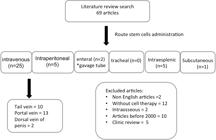PURPOSE:
To evaluate which is the best route of administration for cell therapy in experimental rat model of small-for size syndrome.
METHODS:
A total of 40 rats underwent partial hepatectomy (70%) that induces the small-for-size syndrome and were divided into four groups of route administration: intravenous, intraperitoneal, enteral and tracheal. The small-for-size syndrome model was designed with extended partial hepatectomy (70%). The animals were divided into four groups of routes administration: intravenous (n=10) - intravenously through the dorsal vein of the penis; intraperitoneal (n=10) - intraperitoneally in the abdominal cavity; enteral (n=10) - oroenteral with the placement of a number 4 urethral probe and maintained at third duodenal portion; tracheal (n=10) - after tracheal intubation. We track the animals and monitor them for 21 days; during this follow-up we evaluated the result of cell therapy application tracking animals using ultrasound, radiography and PET-scan. Statistical analysis was performed using GraphPad Prism Software(r). Differences were considered significant with the p<0.05. Data are presented as the median and variation for continuous variables. Comparisons between groups were made using analysis of the imaging test by the researchers.
RESULTS:
All four groups underwent partial hepatectomy of 70% liver tissue targeting the same weight of resected liver. Initially the PET-scan tests showed similarity in administered cells by different routes. However, in few days the route of intravenous administration showed to be the most appropriated to lead cells to the liver followed by enteral. The tracheal and peritoneal routes were not as much successful for this goal.
CONCLUSION:
The intravenous route is the best one to cell therapy in experimental rat model of small-for size-syndrome.
Liver Regeneration; Disease Models, Animal; Stem Cells; Rats

 Thumbnail
Thumbnail
 Thumbnail
Thumbnail
 Thumbnail
Thumbnail
 Thumbnail
Thumbnail
 Thumbnail
Thumbnail
 Thumbnail
Thumbnail





